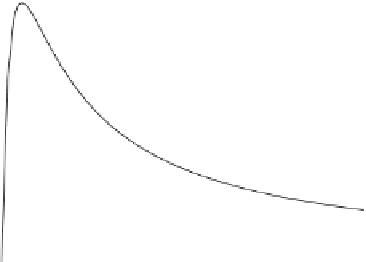Biomedical Engineering Reference
In-Depth Information
(c) two equal-volume CSTRs.
(d) an ideal combination of reactors for total minimum volume for two CSTRs.
8.7. It has been observed that substrate inhibition occurs in the following enzymatic
reaction:
E
þ
S
/
P
þ
E
(a) Show that the rate law for substrate inhibition is consistent with the data shown in
the
Fig. P8.7
below for r
P
,mmol/(L
$
min) versus the substrate concentration of S,
mmol/L.
(b) If this reaction is carried out in a fluidized CSTR with an immobilized enzyme
system. The reactor has a working volume of 1000 L, to which the volumetric flow
rate is 3.2 L/min and the feed concentration of the substrate is 50 mmol/L,
determine the possible conversion of substrate to the desired product. Assume that
there is no loss of the enzyme to the effluent and the effectiveness factor of the
immobilized enzymes is 100%, i.e. no impact of immobilization on the enzyme on
catalytic activity.
(c) How many possible solutions have you obtained in part b)? If more than one
operation outputs are possible, which one would you like to choose to operate?
(d) What is the dilution rate in part b)? What would be the effluent substrate
concentration if the dilution rate is increased by 25%?
8.8. The enzyme-catalyzed reaction:
E
þ
S
P
þ
E
%
The rate of formation P is observed in the lab as shown in
Fig. P8.7
with an enzyme
loading of E
0
¼
50 Units/L. In an industrial application, it is decided that enzyme
loading can be raised to 75 Units/L. This reaction is to be carried out in a fluidized
CSTR with an immobilized enzyme system. The volumetric flow rate is 380 L/h and
the feed concentration of the substrate is 60 mmol/L. Assume that there is no loss of
the enzyme to the effluent, and the effectiveness factor of the immobilized enzymes
0.20
0.18
0.16
0.14
0.12
0.10
0.08
0.06
0.04
0.02
0.00
0
10
20
30
40
50
60
S
, mmol/L
FIGURE P8.7







































































































































Search WWH ::

Custom Search